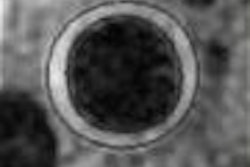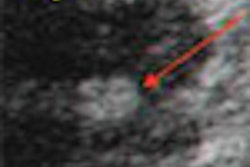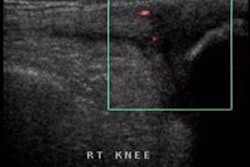Uterine artery Doppler ultrasound does well at predicting abnormal outcomes in high-risk pregnancies, but offers limited value for low-risk patients, according to a pair of papers published in the January issue of Archives of Gynecology and Obstetrics.
To assess the role of uterine artery color Doppler ultrasound waveform analysis in predicting severe complications in a risk population, researchers from the University of Schleswig-Holstein in Lübeck, Germany, performed a prospective study on a patient population with singleton risk pregnancies between 19 and 26 weeks of gestation (Archives of Gynecology and Obstetrics, January 2005, Vol. 271:1. pp. 53-58).
Of the 52 patients included in the study between 1999 and 2001, eight had essential hypertension, 13 had a history of preeclampsia, 13 had a history of intrauterine growth retardation (IUGR), 13 had a history of intrauterine death, and three had a history of placental abruption.
Flow-velocity waveforms were obtained from each uterine artery near to the external iliac artery, before division of the uterine artery into branches. The researchers performed Doppler ultrasound studies between 19 and 26 weeks of gestation.
They tested various uterine artery Doppler ultrasound parameters, including a resistance index (RI) greater than 0.58 and an RI greater than 0.7, as well as uni-/bilateral or bilateral notching.
The researchers found the sensitivity of notching for predicting preeclampsia was 75%, with a relative risk of 2.7. For predicting a severe pregnancy complication, notching had a sensitivity of 69%, with a relative risk of 2.0. Notching yielded a sensitivity of 71% for developing an IUGR, with a relative risk of 2.2.
Employing an RI of greater than 0.58, sensitivity for developing an IUGR was 67% with a relative risk of 5.4. That parameter also turned in sensitivity of 50% for predicting preeclampsia, 75% for intrauterine death, and 80% for severe pregnancy complication, with relative risks of 2.7, 8.1, and 10.90, respectively.
The researchers concluded that uterine artery Doppler ultrasound could be a useful method for predicting severe pregnancy complications in a risk population.
"In any case, the test performed better than risk assessment based on the prevalence of preeclampsia and IUGR alone," the authors wrote. "Evaluation of uterine artery Doppler at 20-24 weeks' gestation can be easily incorporated into the fetal anomaly scan. Patients with bilateral notching or bilateral RI values > 0.7 at 24 weeks' gestation represent a risk group for adverse pregnancy outcome."
Patients with normal flow-velocity waveforms in the uterine arteries at that time of gestation, however, constitute a low-risk group suitable for less-intensive antenatal care, the researchers said.
Low-risk women
Researchers from the same institution also studied the utility of Doppler ultrasound of the uterine artery for predicting severe complications during low-risk pregnancies (Archives of Gynecology and Obstetrics, January 2005; Vol. 271:1, pp. 46-52).
In a prospective study involving 346 low-risk women, the notching parameter produced 88% sensitivity for predicting preeclampsia (with a relative risk of 9.7) and 62% sensitivity for predicting a severe pregnancy complication at any gestational age (with a relative risk of 2.2).
Notching also produced 64% sensitivity (with a relative risk of 2.4) for predicting severe pregnancy complications requiring delivery before 34 weeks, and 56% for developing an IUGR (with a relative risk of 1.7).
An RI greater than 0.58 produced sensitivity of 57% (with a relative risk of 2.1) for predicting a severe pregnancy complication, while an RI greater than 0.70 offered sensitivity of 23% (with a relative risk of 1.9).
As a result, the authors concluded that uterine artery Doppler ultrasound was of limited diagnostic value in predicting adverse pregnancy outcomes in low-risk populations.
"Performing uterine artery Doppler studies at 23-26 weeks’ gestation instead of 19-22 weeks’ gestation increases the predictive value for adverse pregnancy outcomes," the authors wrote.
By Erik L. Ridley
AuntMinnie.com staff writer
February 3, 2005
Related Reading
Ultrasound alters management of infants with genitourinary disorders, October 14, 2004
Embryo and Fetal Pathology: Color Atlas with Ultrasound Correlation, October 13, 2004
Three-dimensional ultrasound shows utility in fetal lung volume measurements, March 18, 2004
Part II: The psychological impact of 3-D ultrasound on pregnant women, December 30, 2003
Part I: The psychological impact of 3-D ultrasound on pregnant women, December 29, 2003
Copyright © 2005 AuntMinnie.com




















